TIP OF THE DAY: Make Turkey Stock
|
|
Years back, we were very friendly with the owner of New York City’s most famous delicatessen. Among other secrets, he told us that the restaurant’s chicken soup was actually turkey soup.
Why? Because the kitchen roasted several turkeys every day for turkey sandwiches (including our favorite combo: turkey, roast beef and chopped liver). What to do with all the leftover carcasses? Make turkey soup, which was called chicken soup on the menu. No one could tell the difference. Why not just call it turkey soup? Because most customers aren’t accustomed to the concept of “turkey soup”; they want chicken soup. In industry terms, it wasn’t a bait-and-switch; most “pumpkin” pie is made with a different orange squash, among other secrets of the trade. You can make either turkey stock or turkey soup with your turkey carcass. We typically make stock, taking advantage of the opportunity to make a lot of it from the large carcass. After all, if you’re going to simmer bones for four hours, would you rather end up with one pint of stock or four pints? |
|
|
RECIPE: TURKEY STOCK Stock Preparation 1. REMOVE all the meat from the turkey carcass. It’s OK if small bits remain. 2. BREAK up the bones of the carcass so they’ll fit in the pot. Place the bones and skin in a large stock pot and cover with cold water by an inch. You can the neck, heart and gizzard (but not the liver). Add a yellow onion that has been quartered, some chopped carrots, parsley, thyme, a bay leaf, celery tops, and some peppercorns. 3. BRING to a boil and immediately reduce heat to a bare simmer—as low as you can make the flame. 4. SIMMER for at least 4 hours, uncovered or partially uncovered (so the stock reduces). At intervals, skim off the foam that rises to the surface. You can reduce the stock as much as you like by continuing to simmer it, uncovered. The more reduced, the more concentrated the flavor (and the less there is to store). 5. REMOVE the bones and and strain the stock through a fine mesh strainer. |
||
|
RECIPE: TURKEY SOUP
If you’d rather make soup than stock, add seasonings to the pot at the beginning of cooking: |
 Want more veggies in your soup? Steam them lightly in the microwave, Then add them to the soup when you reheat it. Photo courtesy Grandma’s Chicken Soup. |
|
|
STOCK, SOUP, BROTH: WHAT’S THE DIFFERENCE? Stock (as well as soup and broth) can be made from any meat or seafood, and from vegetables as well. |
||
